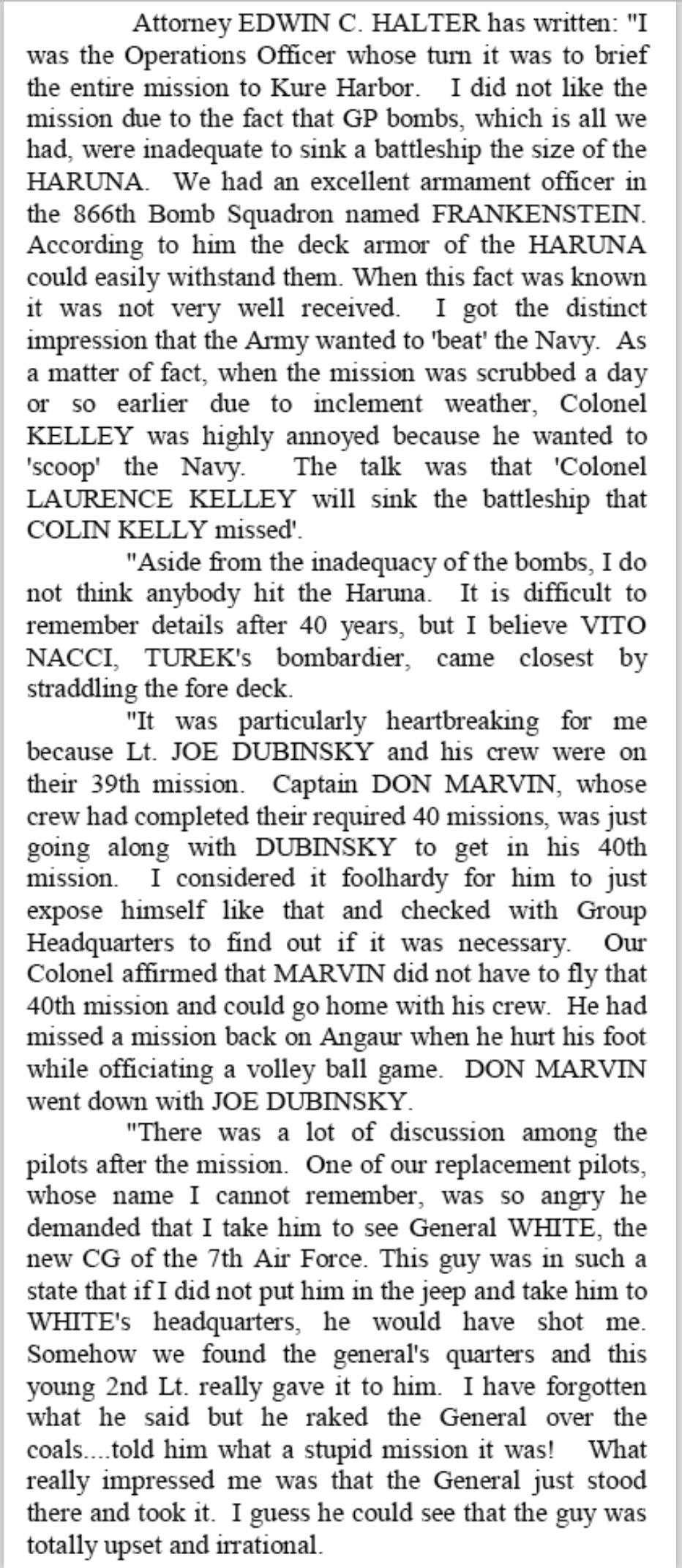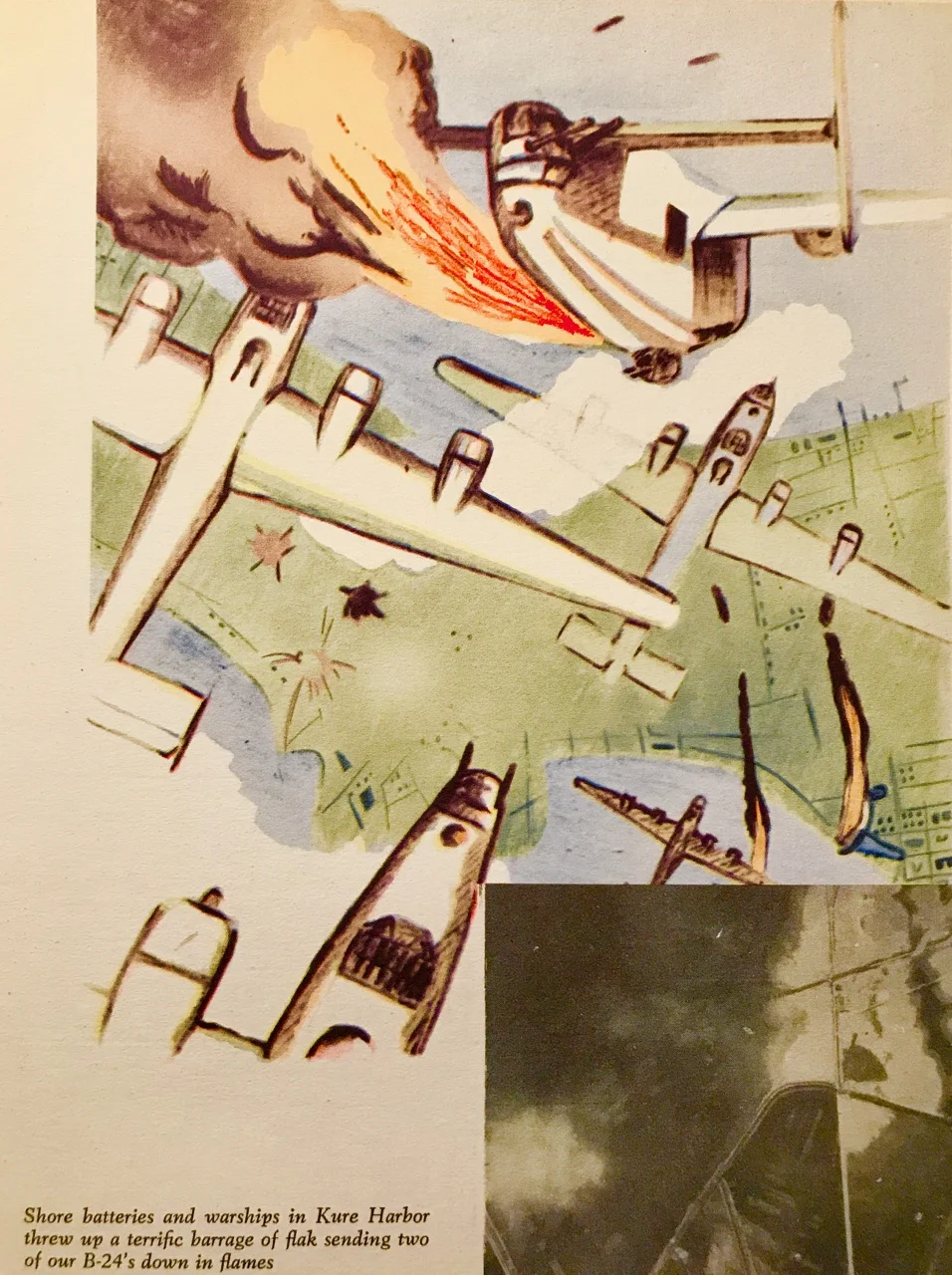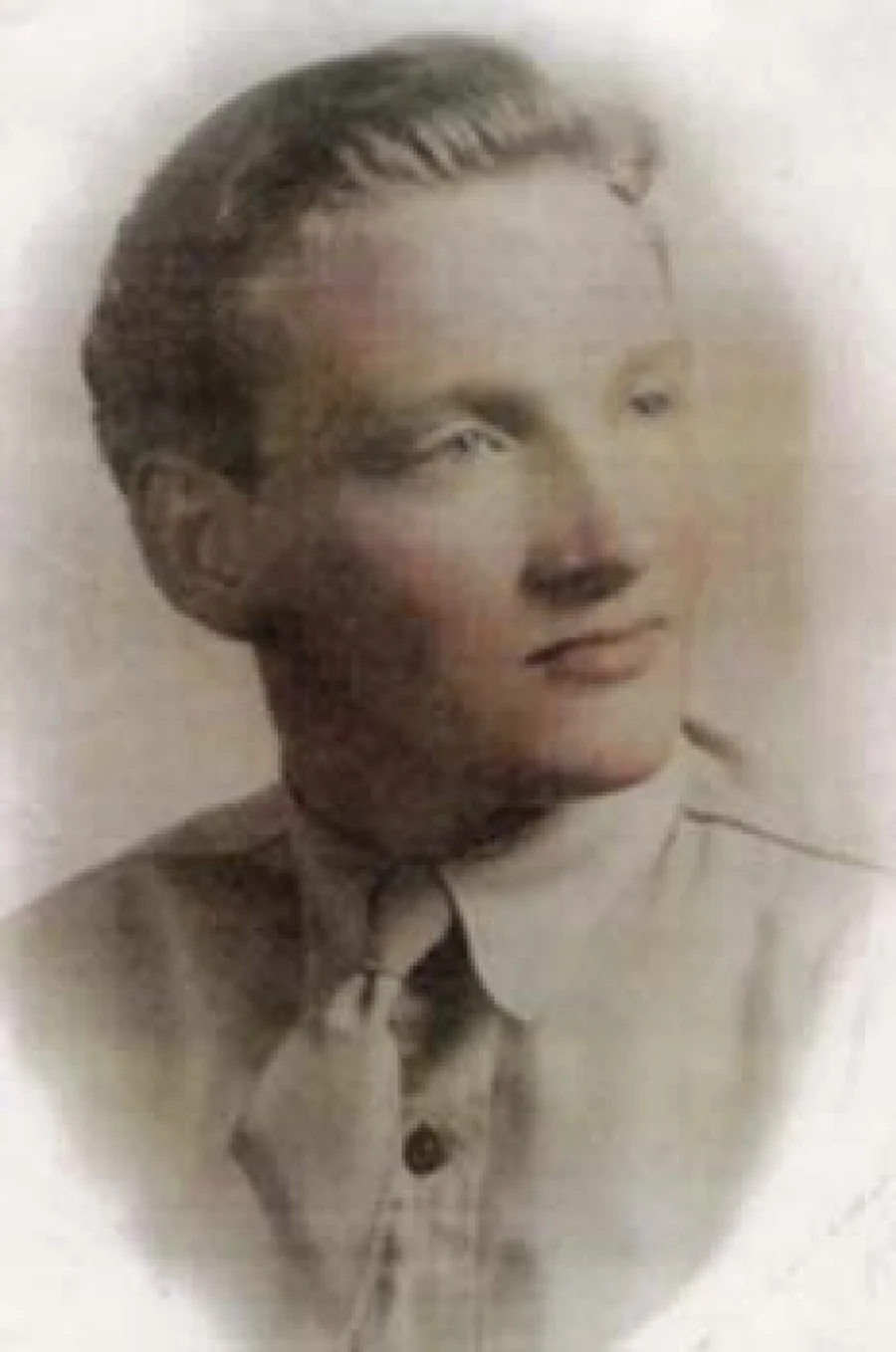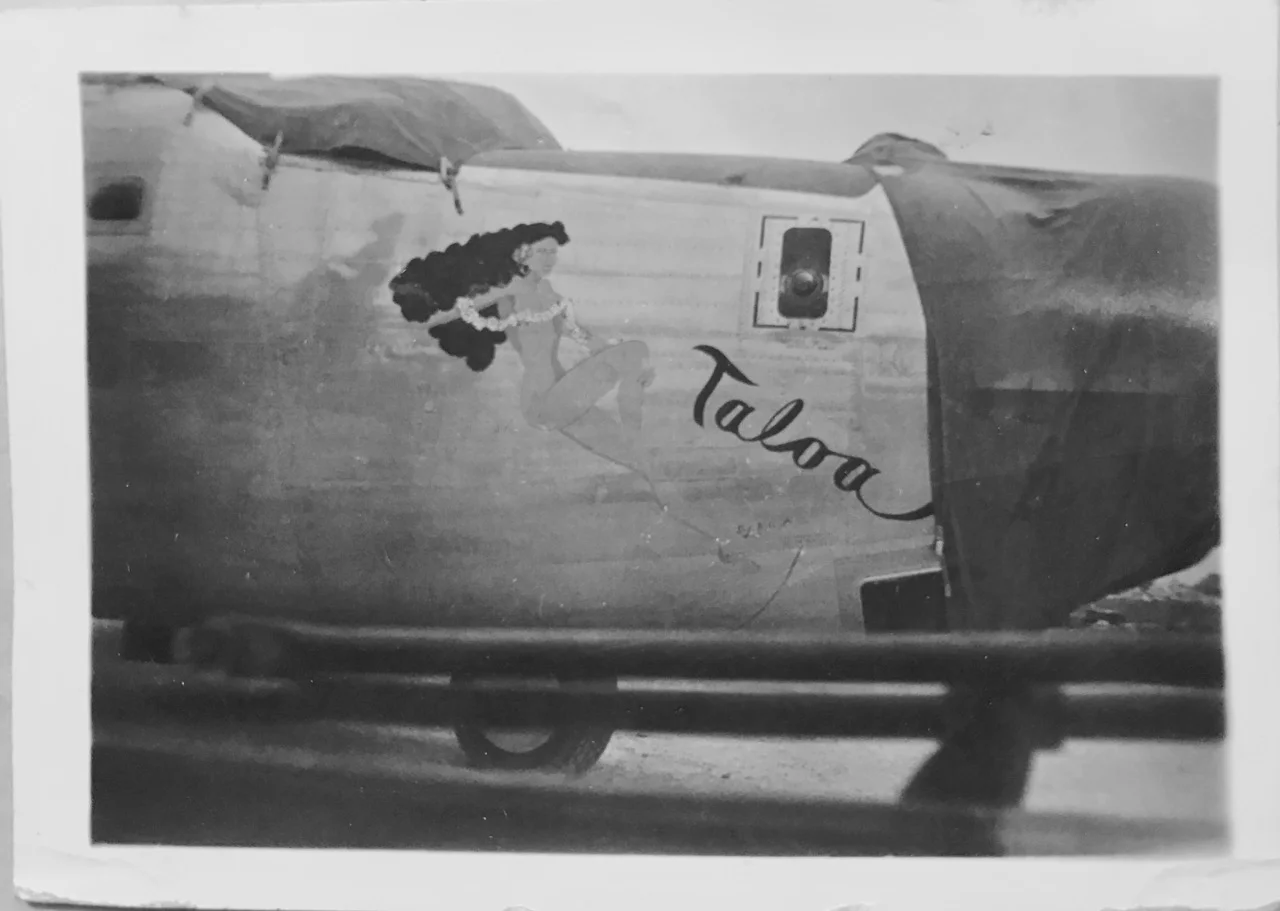






their missions
The crews of the USAAF B-24 bombers Lonesome Lady and Taloa flew their last mission together on 28 July, 1945–to sink the Japanese Fast Battleship BB Haruna. That same day and several days earlier, US Navy aviators were shot down while attacking the Haruna and other military ships of the Imperial Navy at anchor in the Seto Inland Sea of Honshu, Kyushu, and Shikoku, Japan. Twelve of these U.S. Servicemen were held as POWs in Hiroshima and died from their exposures to the blast, fires, and radiation from the atomic bomb that was dropped by the Enola Gay nine days later.
their missions
The crews of the USAAF B-24 bombers Lonesome Lady and Taloa flew their last mission together on 28 July, 1945–to sink the Japanese Fast Battleship BB Haruna. That same day and several days earlier, US Navy aviators were shot down while attacking the Haruna and other military ships of the Imperial Navy at anchor in the Seto Inland Sea of Honshu, Kyushu, and Shikoku, Japan. Twelve of these U.S. Servicemen were held as POWs in Hiroshima and died from their exposures to the blast, fires, and radiation from the atomic bomb that was dropped by the Enola Gay nine days later.
Attack on Warships at kure Harbor
Nearly twenty planes from US Navy aircraft carriers and two Army Air Force B-24 bombers were shot down in the vicinity of Kure, Japan, just a few weeks before the end of World War II. In an earnest effort to demoralize Japanese leadership and end the war, the US military branches were in something like a competition to sink the last floating battleships of the Japanese Imperial Navy. Fleet Admiral Chester Nimitz and Admiral Halsey ordered the US Navy attack on the remaining capital ships of the JIN. Before the attack began on 24 July, 1945, most of these ships were already damaged, without fuel, and trapped in shallow water behind mines near Kure, in the Seto Inland Sea of Japan. Much has been written about the reasons for sinking these ships and criticism of these mission orders. Admiral John “Slew” McCain was against attacking the harbor-bound vessels because they were not a real threat to the US fleet. The B-24 bombers of 494th Bombardment Group of the Seventh Air Force joined the effort from their captured base on Okinawa on 28 July.
The fast battleship Haruna was afloat, relocated from Kure harbor to a bight along the coast of Etajima Island, not far from Hiroshima, Japan. The ship was used for training and defense. The Japanese Navy's equivalent of the US Naval Academy, Annapolis, was located on Etajima. Intense, and demonstrably accurate anti-aircraft artillery (AAA, or ack ack) defended the last Japanese battleship afloat in what was described as an amphitheater of guns.
Imperial Japanese Navy Fast Battleship Haruna under way.
US Navy 3rd Fleet, 38th Task Force Attacks, 24–28 July, 1945
The Haruna under attack on 28 July, 1945, by the US Navy. Photographed from a USS Intrepid (CV-11) plane. Source: U.S. Naval History and Heritage Command Online Library of Selected Images: Photo #: 80-G-490226
The stern of the Haruna appears to be struck by a bomb while other bombs and torpedos explode, as well.
Bombing of Haruna on 28 July, 1945, photographed by a plane launched from the USS Wasp.
H. Paul Brehm chronicled his role in strikes against the Hyuga and Tone as a pilot of a SB2C Helldiver, a then new Navy plane that was nicknamed the Beast.
The heavy cruiser Tone, on 24 July 1945. Raymond Porter and Normand Brissette were brought down while bombing the Tone on 28 July. Having flown into a horrific “box” of flak, at least one of the B-24 planes in the 6th Squadron of the 494th USAAF attack of 28 July reported that they diverted from their bomb run on the Haruna and instead attacked the Tone (viz. correspondence to Emil Turek from Van Curen, courtesy Barbara English, Turek's daughter).
Kelley’s Kobras, US Army Air Force
7th Air Force, 494th Bombardment Group (Heavy), 866th Bomber Squadron, Mission #138
The USAAF 494th Bombardment Group (Heavy) was known as Kelley's Kobras, named for their leader, Col. Laurence Kelley. While many B-24's were lost in the South Pacific during training, transport, and bombing raids, the 494th recorded extraordinary successes by effectively bombing assigned military targets across the South Pacific including the Philippines, while limiting aircraft losses. From the Yontan airfield on Okinawa, veteran pilot 1st Lt. Emil Turek led four B-24 bombers of the 866th Squadron on the 494th’s bombing run of 28 July, 1945. Usually a squadron formation of 6 planes, one was grounded for a maintenance issue and another may have diverted on the way to the target. In all, 35 planes from the 494th Bombardment Group left Okinawa's Yontan Airfield for Kure Harbor. That day, Turek flew as Squadron Leader of the fifth of six assigned 494th Squadrons, but not in his usual plane, the Lonesome Lady. Second Lt. Thomas Cartwright’s crew flew the Lonesome Lady, and they were followed in formation by the crew of veteran pilot Joseph Dubinsky in the Taloa. Nine of these crewmen men were among the twelve Americans who were killed when nine days later the U.S. detonated the first of two atomic bombs used in warfare.
Acting on his concern about anti-aircraft defenses and relying on gut instinct, veteran pilot Turek threaded his way around islands on his way to the initial point where the 866th would line up on the Haruna. For 35 minutes they flew in tight formation and were targeted by anti-aircraft artillery.
This formation sheet records Mission #138 of the 494th Bombardment Group. It includes notes from the 5th Squadron lead pilot, Emil Turek. (Courtesy Barbara English, Turek's daughter.)
“...damn rough mission”
Another plane dropped out of formation due to the flak, bombed “another boat”, and joined up with another squadron to safely return to Yontan. The remaining two B-24J’s were lined up behind Turek and flying a straight and level true course heading of 30 degrees at 10,000 feet . Flying in the radar-bombing equipped, unnamed B-24M bomber A/C #980, Turek's bombardier Vito A. Nacci released his bombs upon the Haruna, which signaled his squadron planes to release theirs, as well. Nearly immediately, each of the three squadron bombers was struck by anti-aircraft flak. The doomed crew aboard A/C #716 took several direct hits and fell abruptly––Taloa was on fire and out of control. Lt. Turek flew the flak-damaged A/C #980 along the struggling Lonesome Lady, which took at least one direct hit near the flight deck, was on fire, and increasingly losing altitude. Burning and losing hydraulic fluids for steering surfaces, Pilot Thomas C. Cartwright was losing complete control of the plane when he ordered bailout over Japan.
Lt. Turek stayed with Lonesome Lady for at least 15 minutes before she spiraled down through low cloud cover and could no longer be seen by Turek and his men. Turek's damaged plane now flew alone. Turek's written history states that the plane could not make it back to Okinawa, some 4 hours away. Another version describes the plane waved off due to a problem with the Yonton airstrip, where they began the mission. Either way, Turek was able to land safely at Ie Shima, an alternative landing site on the return route to Okinawa. The USAAF Missing Air Crew Reports (MACRs) for Lonesome Lady and Taloa include a witness statement signed by Nacci with concurrence from tail gunner Rex. E. Reeves.
Pilot Emil Turek brought his men "home" from the ill-conceived and ill-fated mission #138. None of the Taloa crew returned from this mission; two men from Lonesome Lady returned to Okinawa as repatriated POWs more than a month later. Three bombers were lost since #980 never flew again.
494th BG Mission #138
“I did not like the mission due to the fact that GP (general purpose) bombs which is all we had, were not sufficient to sink a battleship the size of the Haruna...We had an excellent armament officer in the 866th, ...according to him the deck armor of the Haruna could easily withstand them. When this fact was known it was not very well received.”

B-24 Squadron #5 Leader
USAAF 494th Bombardment Group (Heavy), 866th Bomber Squadron
B-24 Squadron #5 Leader
USAAF 494th Bombardment Group (Heavy), 866th Bomber Squadron
B-24M Aircraft serial number 44-50980 (#980)
Lt. Emil Turek of Montgomery Minnesota, mission leader of the 866th Bomber Squadron.
Lead of the 866th B-24 Bomber Squadron #5 on the mission to sink the moored battleship Haruna was Lt. Emil Turek, piloting aircraft A/C #980 in the #1 formation position. Turek and his crew usually flew Lonesome Lady and Turek was not entirely happy to be assigned to a different bomber that day. In formation, the Lonesome Lady was piloted by 2nd Lt. Thomas Cartwright in position #2, to the left and behind #980. The Taloa was piloted by Joseph Dubinsky in position #4, directly behind and slightly lower than #980. Only these three planes from the 866th arrived over the target, the Haruna. William O'Brien, in #672, Tiny Mac, wrote that he diverted due to intense flak and dropped his bombs on another target. (His bombardier, Alfred Miller, wrote that intense target drove them to target “another boat”.) Robert Smith, pilot of #052, Liquidator, told Turek’s navigator, Rolf Slen, that #980 disappeared behind a curtain of black smoke from flak and they never saw the lead plane again. Junius G. Van Curen, the 866th Lead Pilot of the Squadron #6 in the 494th formation that day, wrote in a letter to Turek that his squadron diverted and bombed the Japanese Heavy Cruiser Tone. The Tone was moored off Etajima. Her stern rested on the shallow bottom, damaged by 3 bombs in a 24 July attack and hit again during a raid which determined Raymond Porter and Normand` Brissette’s fates in Hiroshima. Van Curen did not address why Squadron #6 did not bomb the Haruna.
Artwork from Briton Martin's Kelley's Kobras: 494th Group History, 1947. The artist is unidentified but may have been a pilot in the 866th Squadron, Gareth Williams.
Turek and his men completed four additional combat missions before the war ended just a few weeks later. In his post-war correspondence he expressed life-long remorse about this particular mission, the loss of a close friend, and the loss of the crews on the Taloa and their Lady. Turek's navigator, Rolf Slen, wrote a series of memoirs about his war experiences. With him, as well, the Haruna mission was by far the most troubling.

B-24 Lonesome Lady
Cartwright Crew
B-24 Lonesome Lady
Cartwright Crew
“On July 28, 1945, our flight crew got up about 5:30 a.m., ate breakfast and was briefed. We left for the flight line of Yontan Airfield to locate B-24 A/C 44-40680––the Lonesome Lady; we had admired-her art but never flown her.”
The Lonesome Lady
On 28 July, Replacement Crew 42B flew the B-24J bomber Lonesome Lady to attack the Battleship Haruna, moored just offshore from Etajima, near Kure Harbor, Honshu, Japan. Piloted by 21-year-old 2nd Lt. Thomas Cartwright, the extensively trained crew was one of the last B-24 crews to be deployed in the war. The Lonesome Lady, her crew on the Haruna bombing mission, and the original crew––(Emil Turek's Crew #39) each have webpages dedicated to them on this site.
The Lonesome Lady flew over the target in #2 position, just behind and to the left of A/C #980.
Of the nine crew members of the Lonesome Lady, one died during the mission when he bailed out and his parachute failed to open, eight became POWs, six of them were killed by the blast or radiation exposure of the atomic bombing of Hiroshima, and two returned home after the war. This tribute tells more about the men. Historian Shigeaki Mori tells the story of their mission and his discovery of their fates in his book here on this website.
Top row, left to right: 2nd Lt. James M. Ryan (Bombardier), 2nd Lt. Durden W. Looper (Co-pilot), 2nd Lt. Thomas C. Cartwright (Pilot in Command), 2nd Lt. Roy M. Pedersen (Navigator)
Bottom row left to right: Sgt. Hugh H. Atkinson (Radio Operator Mechanic), Sgt. Buford J. Ellison (Engineer), Sgt. William E. Abel (Tail Gunner) with Blackie, Corp. John A. Long, Jr. (Nose Gunner). Also pictured: Frank Baker (Gunner), who was replaced on the final mission by Ralph J. Neal.
The Missing Aircraft Report included this statement by the Haruna mission lead plane #980 Bombardier Vito "'lil Davey" Nacci and crewmate Rex Reeves.
Sgt. Ralph J. Neal
Ball Turret Gunner Neal flew on the Lonesome Lady mission to bomb the Haruna in the place of Replacement Crew 42B crew member Frank Baker the day it was shot down.
Photographs and much more information about the crew and their plane, Lonesome Lady, are available on this website and elsewhere on the internet, a published account by Lt. Thomas Cartwright, and in archives that contain military records and collections of personal documents and photographs.

B-24 Taloa
Dubinsky Crew
B-24 Taloa
Dubinsky Crew
The Taloa and Her Crew
B-24J S/N #44-40716, 7th U.S. Army Air Force, 494th Bombardment Group, 866th Bomber Squadron
On the 28 July mission to bomb the Japanese Battleship Haruna, the Taloa was flown by one of the original flight crews of the 494th Bombardment Group, Joseph Dubinsky's Crew #49. Joe Dubinsky's crew survived many long and dangerous combat missions over the Philippines and other islands, flying the B-24J 'Til Then from Angaur, Palau. Dubinsky had become a close friend to the 866th Squadron leader, Emil Turek.
Taloa crew. In this undated photo, Joe Dubinsky's crew of the Taloa on 28 July, 1945, poses in front of the partially visible "nose art" of the Lonesome Lady.
Top row from left: 1st Lt. Joseph Dubinsky (Pilot), 1st Lt. Rudolph Flanagin (Co-pilot), 1st Lt. Robert C. Johnston (Bombardier), 1st Lt. Lawrence Falls (Navigator), T/Sgt. Walter Piskor
Bottom row from left, T/Sgt. David Bushfield, S/Sgt. Camillous Kirkpatrick, S/Sgt. Charles Baumgartner, S/Sgt. Charles Allison. Not shown are S/Sgt Julius Molnar (Tail Gunner) and observer Captain Donald F. Marvin. Photo: Courtesy of Mr. David H. Rogers.
The nose art of the Taloa. She is said to be named after a pilot's girlfriend in Panama. She completed 44 combat missions.
Missions from Yontan, Okinawa
Lt. Turek was Dubinsky's Squadron Leader, flying Lonesome Lady on their first combat mission from Okinawa on 5 July, 1945. It was Turek's 30th combat mission, and the first B-24 raid from Okinawa on the main islands of Japan. The 494th Bombardment Group had arrived in strength less than 24 hours earlier at the captured Yontan Airfield at Yomitan, Okinawa. The men knew something of the months-long battle to take the island in the 7th Army Air Force’s campaign to attack homeland Japan from the air. Fighting continued on Okinawa, and they were yet to feel the full force of desperate Japanese kamikaze and parachute attacks. They were proud to have launched 48 planes in just 48 minutes. Turek was concerned when Dubinsky, flying the unnamed B-24 S/N #980, aborted that mission due to a mechanical problem. After the mission, Turek recorded the his friend’s safe return simply by marking Dubinsky’s name out on his Formation Sheet.
The original crew that was assigned to Taloa was Donald Marvin's Crew, #46. However, for the desperate mission on 28 July, 1945, Marvin boarded with Dubinsky’s crew on the Taloa.
A long-told back-story is that Don Marvin was unassigned but flew the desperate mission so that he would complete 40 combat missions. It was an honorable but fateful and unfortunate decision, since none of the men aboard Taloa returned from the mission. The 494th’s Group History tells the story that although Marvin missed one of his crew’s previous missions due to an injury while officiating a volleyball game back on Palau, Marvin knew that he was not required to fly another combat mission and was cleared to return stateside for furlough or reassignment with the rest of his crew. This widely told story that explains why Marvin was aboard Taloa conflicts with an account provided by Dubinsky’s (half-)brother, Branko Stupar to 494th Bombardment Group historian, Dave Rogers. Stupar was a 21-year-old US Navy Officer at Okinawa in charge of a landing craft that was carrying fuel and bombs on shore. Stupar was given permission to fly on Taloa as an observer. According to Stupar, he showed up to the briefing for the Haruna mission, but was bumped off by Marvin. A flight surgeon asked Marvin to fly as a relief pilot to Dubinsky, because Dubinsky had been diagnosed with a heart defect. There is some circumstantial evidence to support this account: 866th Formation Sheets that document August missions show that Marvin’s crew did, in fact, fly several subsequent combat missions with Co-pilot Lowell Green. The Missing Air Crew Report that was filed for Taloa records Marvin’s role as “Observer”. That may have been a designation carried over from Stupar’s previously assigned role that day, or perhaps it indicated that Marvin was observing Dubinsky.

Raymond Porter Normand Brissette
USN SB2C-4E Helldiver BuNo 21079
Raymond Porter Normand Brissette
USN SB2C-4E Helldiver BuNo 21079
Task Group 38...
As a member of Bombing Squadron VB-87, operating from the U.S. Aircraft Carrier CV-14 Ticonderoga, Lieutenant Junior Grade Raymond Porter and Airman 3rd-class Normand Brissette launched at 7:50 AM in a dive bomber, the SB2C-4E Helldiver, Bureau Number 21079 (shown in formation above with tail number 210). Their mission on 28 July, 1945, was part of the US Navy's 39-plane attack on the Japanese Heavy Cruiser Tone. One of the last men to see Porter and Brissette before they ditched and were captured as POWs was fellow squadron pilot Paul Brehm. Flying tail number 205 (also shown in formation, above), Brehm wrote an account of his mission experience during and after the bombing run on the Tone...
Paul Brehm was a USN VB-87 Bombing Squadron pilot in BuNo #206 during the attack on the Hyuga on 24 July, 1945, ditched it, survived, then flew#205 to dive-bomb the Tone on 28 July, 1945. (Image courtesy of S. Mori)
“The Skipper was leading this strike and as his section leader I had Pucci on my wing, and Porter was taking Vaughn’s place on the Skipper’s starboard wing...I pulled out high and on the way to the rendezvous position Tommy was cranking pictures again. Porter joined the formation, but he had been hit and his plane was smoking badly. He made the rendezvous area where he had to ditch. We expected DUMBO to get him, but Jap ships in the vicinity got to him first.”
The Heavy Cruiser Tone, was the target of Raymond Porter and Normand Brissette on 28 July, 1945. H. Paul Brehm recognized Tone as the only Japanese vessel with four gun turrets forward.
The SB2C-4E Beast was fitted with APS-4 search radar and could be fitted with wing racks for eight 5 inch (127 mm) rockets or 1,000 lb (454 kg) bombs. The last dive-bomber designed, it replaced the slower Douglas SBD Dauntless. Although the Beast was a faster aircraft, losses due to anti-aircraft fire were heavy.

Ensign John Hantschel
F6F-5 HELLCAT BuNo 77934 on 25 July, 1945 from US Aircraft Carrier CV-15 Randolph.
Ensign John Hantschel
F6F-5 HELLCAT BuNo 77934 on 25 July, 1945 from US Aircraft Carrier CV-15 Randolph.
Ensign John J. Hantschel
Ensign John J. Hantschel was assigned to fighter unit VF-16 aboard the U.S. Aircraft Carrier CV-15 U.S.S. Randolph. On 25 July, 1945, he flew the US Navy's F6F-5 fighter aircraft Bureau Number 77934.
Flying solo in his Hellcat fighter, Hantschel's mission to one of the three main islands of Japan, Shikoku, ended with him splashing down in the Seto Inland Sea. He was taken prisoner and brought to the Chugoku Military Police Headquarters in Hiroshima.
The Secret History of...
The Secret History of...
The on-line publication of Mr. Shigeaki Mori's book
The Secret History...
The story of the American POWs who were tragically killed while held prisoner in Hiroshima just a few hundred meters from ground-zero is told here. Against all odds, Hibakusha (atomic bomb survivor) and award-winning author Shigeaki Mori spent several decades to learn what happened to the Americans, and to research, write, and publish his findings. His book The Secret History of American Soldiers Killed by the Atomic Bomb was translated to English in 2017 and is now fully available here.
Archives
And arriving information
Archives
And arriving information
The American POWs of WWII Hiroshima
(currently only returns to the top of this page)
Additional content will include maps, photographs, illustrations from the hibakusha, and additional reference materials regarding the POW experiences during the last month of the war...
Search this website
Search the complete contents of this website using any keyword(s), e.g, Ikachi, Yanai, Choguko, Omori, Kure, Haruna, Cartwright, Turek, Porter, Brissette, Neal, Mori, Muranaka, Fujinaka, Kondo, Taloa, Lonesome Lady,
Barry Frechette's documentary film Paper Lanterns tells the story of the twelve American POWs who perished in the atomic bombing of Hiroshima, and how historian Shigeaki Mori slowly uncovered the story and shared it and much more with the men's families.








